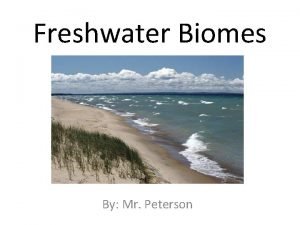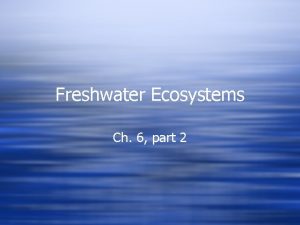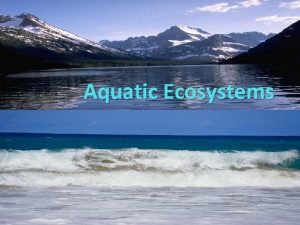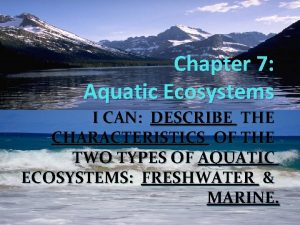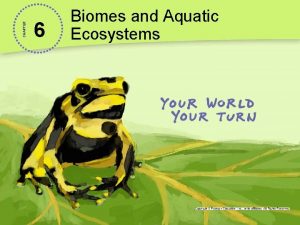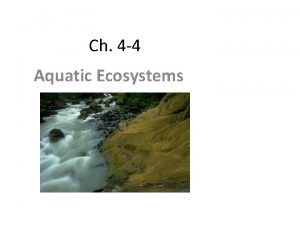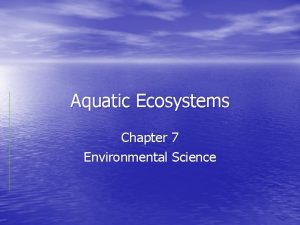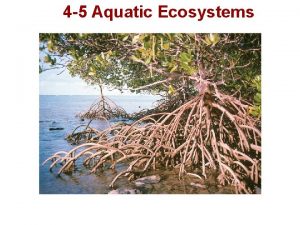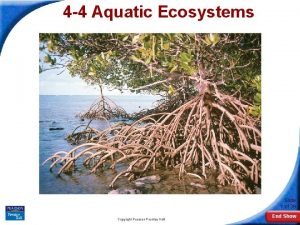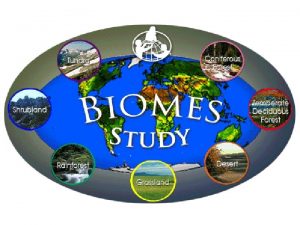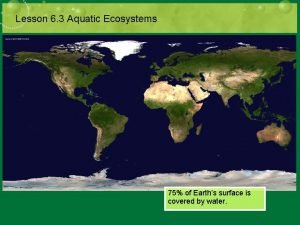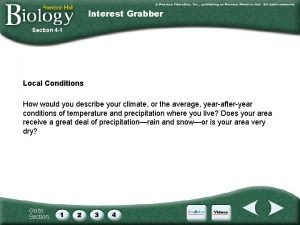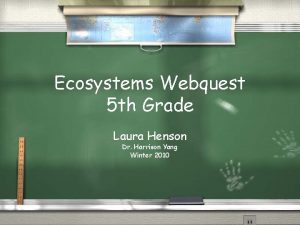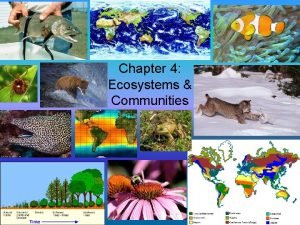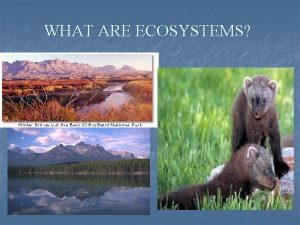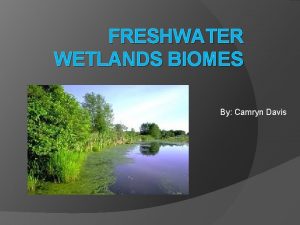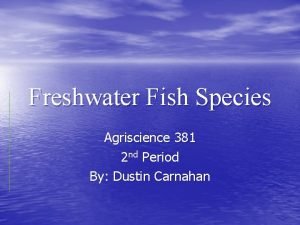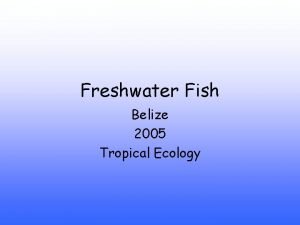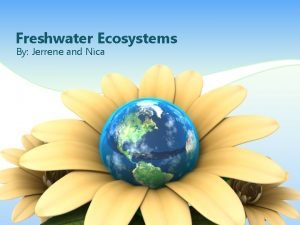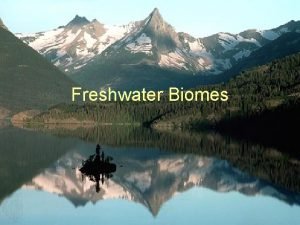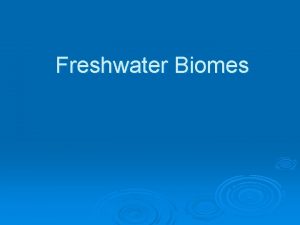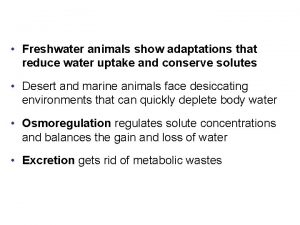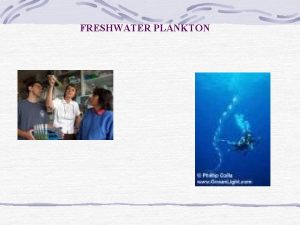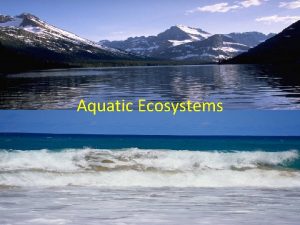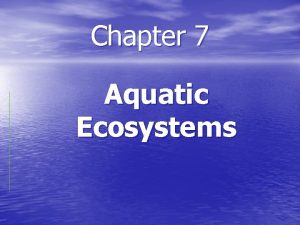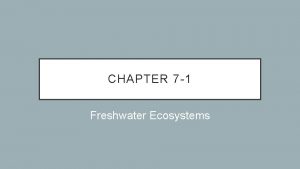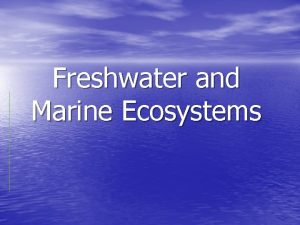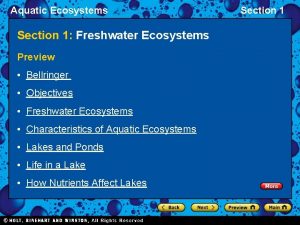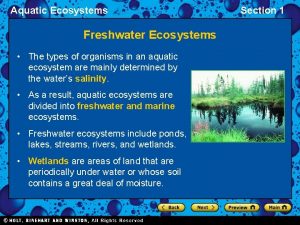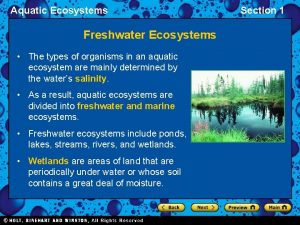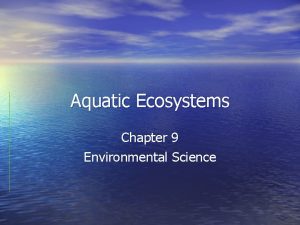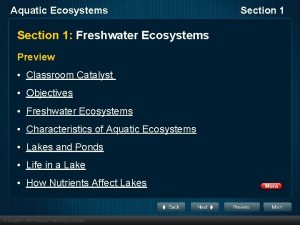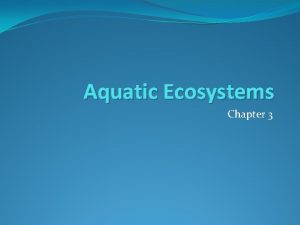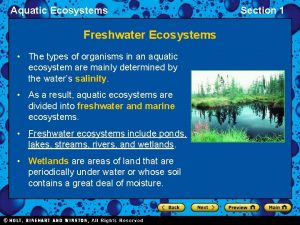Freshwater ecosystems Kinds Characteristics Threats 10515 Aquatic ecosystems





























- Slides: 29

Freshwater ecosystems Kinds Characteristics Threats 10/5/15

Aquatic ecosystems l l l Key distinction: salinity = salt content of the water Measured in parts per thousand (ppt) 1 gm of salt in 1000 gms water = 1 ppt FRESH usually < 0. 5 ppt OCEANS average 35 ppt 0. 5 to 17 ppt is called BRACKISH

BRACKISH l Brackish = more salinity than freshwater, but less than seawater – It can come from the mixing of the two systems (as in estuaries)

Kinds of freshwater habitats l Rivers, streams – – – Flowing freshwater Source: where it starts Mouth: where it ends l Lakes, ponds l Wetlands

All freshwater ecosystems l Just a fraction of the Earth’s water – l . 01% = one-hundredth of one percent Occupy less than 1 percent of the Earth’s surface

Rivers and streams l More than 3. 5 million miles of rivers and streams (including intermittent streams) – Just the U. S. ! More than 140 times around the Earth. www. noaa. gov/str-plan/images/river. gif

Rivers from start to finish l l Source = Headwaters Can be: – – – l l Snowmelt Spring Even a lake Water is colder, clearer, more highly oxygenated Organisms include trout, mayflies l l l Mouth: where the river ends Usually the ocean or another river, or lake River widens and slows, getting warmer, siltier. Middle is most diverse, lots of plants Near mouth, increased sediment limits light and plants, water is warmest

What are some of the differences? l Trout stream, NW NJ Mississippi R. Greenville, MS

Mouth Mississippi River delta l

Lakes and ponds l What’s the difference? – – – Ponds typically smaller May be seasonal—that is, dry up part of the year Lakes exist hundreds or thousands of years l But, even lakes can fill in or dry up


Parts of a lake

Parts of a lake l Littoral zone: near shore – – l Limnetic zone: near surface, open water – – l l Nutrient rich, lots of plant and animal life Warm Lots of light Lots of plankton Profundal zone: deeper, little light Benthic zone: the bottom, little light, low oxygen


Eutrophication l l If nutrients increase too much in a lake, pond, or ocean, excessive plant growth results Phosphorus Nitrogen NOT GOOD: why? – – As plants decay, decomposing bacteria use oxygen dissolved in the lake to do their jobs. Dissolved oxygen goes down

Wetlands l CA OR AK

Wetlands: what are they? l For regulatory purposes under the Clean Water Act, the term wetlands means "those areas that are inundated or saturated by surface or ground water at a frequency and duration sufficient to support, and that under normal circumstances do support, a prevalence of vegetation typically adapted for life in saturated soil conditions. Wetlands generally include swamps, marshes, bogs and similar areas. "

Wetlands l l May be fresh or brackish Freshwater types include: – – Marsh Swamp Bog Fen

Marsh l l l Most common freshwater wetland in U. S. Occur along streams or in depressions Characterized by organic, wet soils and non-woody (i. e. , no trees) vegetation.

Marsh

Swamp l l Wetland dominated by woody plants Common in SE U. S.

Swamp

Caddo Lake! You will be researching Caddo Lake for homework this week.

New Jersey wetlands l About 916, 000 acres, or 19% of New Jersey, is wetlands, which seems like a lot; l About 40% of the original 1, 500, 000 acres has been lost to dredging and filling, dams, farming, development and highways.

What good are wetlands? l Reduce flooding by acting like sponges

What good are wetlands? l Help clean water by acting like a filter: – The plants and slow water flow in a wetland help remove pollutants, leaving water cleaner downstream in a lake or river. – Too much pollution can leave a wetland toxic to visiting animals, such as many birds.

What good are wetlands? l Protect shorelines from erosion l Erosion in this case came from grazing animals

Threats to Wetlands l The importance of wetlands as purifiers of wastewater and absorbers of other hazardous flood waters is now recognized. l Wetlands are also vitally important as habitats for wildlife. l The federal government and most states now prohibit destruction of certain wetlands.

National Wetlands Inventory Mapper l http: //www. fws. gov/wetlands/Data/Mapper. html
 Fun facts about freshwater ecosystems
Fun facts about freshwater ecosystems Lentic ecosystem
Lentic ecosystem Section 1: freshwater ecosystems
Section 1: freshwater ecosystems Freshwater ecosystems are classified as
Freshwater ecosystems are classified as Lesson outline lesson 2 aquatic ecosystems answer key
Lesson outline lesson 2 aquatic ecosystems answer key Chapter 3 section 3 aquatic ecosystems
Chapter 3 section 3 aquatic ecosystems What are the two main types of aquatic ecosystems
What are the two main types of aquatic ecosystems The chaparral biome is best characterized by _______.
The chaparral biome is best characterized by _______. Why biomes are important
Why biomes are important Chapter 3 lesson 3 biomes and aquatic ecosystems
Chapter 3 lesson 3 biomes and aquatic ecosystems Section 4-4 aquatic ecosystems
Section 4-4 aquatic ecosystems Differences between aquatic and terrestrial ecosystems
Differences between aquatic and terrestrial ecosystems Describe aquatic ecosystem
Describe aquatic ecosystem Limestone ridges built by tiny animals
Limestone ridges built by tiny animals 4-4 aquatic ecosystems
4-4 aquatic ecosystems Section 4-4 aquatic ecosystems answer key
Section 4-4 aquatic ecosystems answer key Chapter 7 aquatic ecosystems test answers
Chapter 7 aquatic ecosystems test answers Biomes and aquatic ecosystems
Biomes and aquatic ecosystems Lesson 3: aquatic ecosystems
Lesson 3: aquatic ecosystems Section 4-2 what shapes an ecosystem answer key
Section 4-2 what shapes an ecosystem answer key Aquatic ecosystems webquest
Aquatic ecosystems webquest Section 4-4 aquatic ecosystems
Section 4-4 aquatic ecosystems Non living things in grassland
Non living things in grassland Climate of freshwater wetlands
Climate of freshwater wetlands Texas freshwater fish species
Texas freshwater fish species Freshwater fish of belize
Freshwater fish of belize Abiotic factors in freshwater
Abiotic factors in freshwater Freshwater biome climate
Freshwater biome climate Open water
Open water Freshwater animals adaptations
Freshwater animals adaptations
